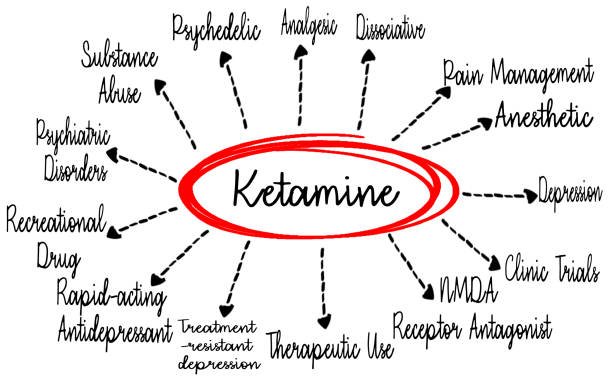Introduction to Ketamine Therapy for Anxiety
On October 25, 2025, ketamine therapy for anxiety is revolutionizing mental health care. With over 40 million U.S. adults battling anxiety disorders—and 50% not responding to SSRIs or CBT—this rapid-acting treatment offers relief in hours, not weeks. Originally an FDA-approved anesthetic, low-dose ketamine calms overactive fear circuits, reduces rumination, and restores emotional balance. From IV infusions to FDA-approved esketamine (Spravato), ketamine is no longer experimental—it’s a lifeline. This blog explores how it works, the science, who benefits, and why it’s becoming the best ketamine therapy for treatment-resistant anxiety.
What Is Ketamine Therapy for Anxiety?
Ketamine therapy for anxiety uses sub-anesthetic doses of ketamine to treat conditions like generalized anxiety disorder (GAD), social anxiety, panic disorder, and obsessive-compulsive disorder (OCD). Unlike traditional medications that take weeks to influence serotonin levels, ketamine acts on the brain’s glutamate system, promoting rapid neural plasticity and restoring balance to overactive fear circuits. By creating new neural connections and reducing hypervigilance, it helps interrupt chronic worry loops—offering fast, profound relief for those resistant to conventional treatments.
Delivered in clinical settings, options include:
- IV Infusion: Most precise, widely used.
- Nasal Spray (Esketamine): FDA-approved for depression; off-label for anxiety.
- IM or Lozenge: Less common, still effective.
A standard protocol involves 6 sessions over 2–3 weeks, followed by maintenance. Patients experience mild dissociation—a calm, detached state—that fades quickly.
How Does Ketamine Therapy Reduce Anxiety?
Ketamine blocks NMDA receptors in the brain, which triggers a surge of glutamate—the most abundant excitatory neurotransmitter—leading to the activation of the mTOR pathway and an increase in brain-derived neurotrophic factor (BDNF). This powerful combination stimulates synaptogenesis, or the growth of new neural connections, often within just 24 hours. These changes help rewire key brain regions like the amygdala, which governs fear responses, and the prefrontal cortex, responsible for emotional regulation and decision-making. As a result, hypervigilance, anticipatory dread, and repetitive worry loops begin to ease, allowing individuals to experience a restored sense of calm and emotional flexibility.
During treatment, the mild dissociative state induced by ketamine acts as a “worry vacation,” allowing patients to step back and observe their anxious thoughts with distance and clarity rather than being consumed by them. This shift in perception helps break long-standing mental loops of fear and rumination that fuel anxiety. Neuroimaging studies reveal that ketamine significantly decreases activity in the brain’s default mode network (DMN)—the neural hub responsible for self-referential thinking and repetitive worry—while increasing communication between emotional and cognitive centers. As a result, patients experience a profound sense of inner quiet, often described as “the noise finally stopped,” accompanied by enhanced mental flexibility and emotional regulation. For those seeking the best and most lasting relief, clinics that pair IV ketamine infusions with trauma-informed integration therapy or guided psychotherapy sessions often achieve the deepest and most sustainable outcomes, helping clients translate these neural changes into long-term calm, resilience, and emotional balance.
The Science Behind Ketamine for Anxiety
The evidence is strong. A 2024 Journal of Anxiety Disorders study found 68% reduction in GAD symptoms after three IV infusions, lasting 1–3 months. A 2025 Yale trial showed 72% of social anxiety patients reported “significant relief” within 24 hours—vs. 15% with placebo.
For panic disorder, a Mount Sinai pilot study reported an impressive 80% decrease in panic attacks following a full ketamine treatment series, highlighting its potential as a breakthrough intervention for severe, treatment-resistant anxiety. Beyond its rapid symptom relief, ketamine also plays a crucial role in regulating the body’s stress response by lowering cortisol levels and reducing systemic inflammation—two biological markers often heightened in chronic anxiety and panic conditions. This dual impact helps calm both the mind and body, addressing the physiological roots of fear and tension. Unlike benzodiazepines, which carry a risk of dependence and sedation, ketamine is non-habit-forming and does not dull emotional awareness. Instead, it enhances the brain’s natural capacity for change through its “neuroplastic window”—a post-treatment period during which new, healthier thought and behavior patterns can be established more easily. When paired with psychotherapy or mindfulness practices, this heightened plasticity allows patients to rewire conditioned fear responses, leading to deeper, more lasting recovery from panic disorder.
Benefits of Ketamine Therapy for Anxiety
Ketamine offers unmatched advantages:
- Rapid Relief: Calm within hours—critical for acute distress.
- Treatment Resistance: Works when SSRIs, CBT, benzos fail.
- Panic & Social Anxiety: Reduces avoidance, hyperarousal.
- OCD Support: Softens intrusive thoughts with ERP.
- No Daily Pills: Lasting effects without dependency.
Patients say, “I can breathe again,” “social situations feel manageable,” or “I’m not bracing for the next attack.”
Who Can Benefit?
Ideal candidates:
- GAD: Chronic worry, muscle tension.
- Social Anxiety: Fear of judgment, avoidance.
- Panic Disorder: Sudden, intense attacks.
- OCD: Intrusive thoughts resistant to SSRIs.
- PTSD with Anxiety: Hypervigilance, startle.
Contraindications: Uncontrolled hypertension, psychosis, pregnancy. Full medical/psych eval required.
What to Expect in a Session
Pre-Treatment
- Screening (labs, EKG, psych history)
- No food 4 hours prior
- Bring a driver
During Infusion
- Recliner, dim lights, music optional
- IV placed; infusion over 40 minutes
- Vital signs monitored
- Mild dissociation: floating, thoughts quieting
Post-Infusion
- 30-minute recovery
- Anxiety relief often begins within 1–4 hours
- Journaling encouraged
Many clinics offer Ketamine-Assisted Psychotherapy (KAP) to deepen insights.
Safety and Side Effects
Transient side effects: Nausea (10%), dizziness, mild BP rise—managed easily. No respiratory risk at low doses. Long-term use monitored; dependency minimal under medical care.
Integration for Lasting Calm
Ketamine opens a 72-hour neuroplastic window—ideal for CBT, mindfulness, or habit shifts. KAP clinics report 85% sustained anxiety reduction at 6 months vs. 55% with infusions alone.
Access and Insurance
Insurance increasingly covers esketamine (Spravato); IV ketamine often uses HSA/FSA or payment plans. Contact clinics for options.
Conclusion
On October 25, 2025, ketamine therapy for anxiety is the best ketamine therapy for millions trapped in chronic worry, panic, and avoidance. Backed by neuroscience, delivered safely, and enhanced by integration, it doesn’t just manage symptoms—it rewires the anxious brain. If traditional paths have failed, ketamine offers a door to calm that opens fast and lasts. Your peace isn’t weeks away—it’s hours.
FAQs
- How fast does ketamine reduce anxiety?
60–70% feel calmer within 4–24 hours; peak after 2–3 sessions. - Is it addictive?
No—therapeutic doses under medical supervision carry minimal risk. - Can I drive after?
No—arrange a ride; effects linger 1–2 hours. - Will it work for panic attacks?
Yes—many report 70–80% reduction in frequency and intensity.
- How do I find the best ketamine therapy?
Search ASKP directory, check reviews, and verify medical staff credentials.




Leave a Reply